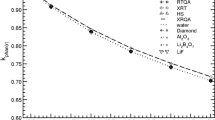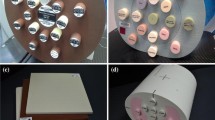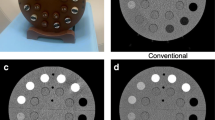Abstract
For accurate tissue-inhomogeneity correction in radiotherapy treatment planning, the author previously proposed a conversion of the energy-subtracted computed tomography (CT) number to electron density (ΔHU–ρe conversion). The purpose of the present study was to provide a method for investigating the accuracy of a photon-counting detector (PCD) used in the ΔHU–ρe conversion by performing dual-energy CT image simulations of a PCD system with two energy bins. To optimize the tube voltage and threshold energy, the image noise and errors in ρe calibration were evaluated using three types of virtual phantoms: a 35-cm-diameter pure water phantom, 33-cm-diameter solid water surrogate phantom equipped with 16 inserts, and another solid water surrogate phantom with a 25-cm diameter. The third phantom was used to investigate the effect of the object’s size on the ρe-calibration accuracy of PCDs. Two different scenarios for the PCD energy response were considered, corresponding to the ideal and realistic cases. In addition, a simple correction method for improving the spectral separation of the dual energies in a realistic PCD was proposed to compensate for its performance loss. In the realistic PCD case, there exists a trade-off between the image noise and ρe-calibration errors. Furthermore, the weakest image noise was nearly twice that for the ideal case, and the ρe-calibration error did not reach practical levels for any threshold energy. Nevertheless, the proposed correction method is likely to decrease the ρe-calibration errors of a realistic PCD to the level of the ideal case, yielding more accurate ρe values that are less affected by object size variation.












Similar content being viewed by others
References
Parker RP, Hobday PA, Cassell KJ. The direct use of CT numbers in radiotherapy dosage calculations for inhomogeneous media. Phys Med Biol. 1979;24(4):802–9.
Constantinou C, Harrington JC, DeWerd LA. An electron density calibration phantom for CT-based treatment planning computers. Med Phys. 1992;19(2):325–7.
Schneider U, Pedroni E, Lomax A. The calibration of CT Hounsfield units for radiotherapy treatment planning. Phys Med Biol. 1996;41(1):111–24.
du Plessis FCP, Willemse CA, Lotter MG, Goedhals L. The indirect use of CT numbers to establish material properties needed for Monte Carlo calculation of dose distributions in patients. Med Phys. 1998;25(7):1195–201.
Saito M. Potential of dual-energy subtraction for converting CT numbers to electron density based on a single linear relationship. Med Phys. 2012;39(4):2021–30.
Tsukihara M, Noto Y, Hayakawa T, Saito M. Conversion of the energy-subtracted CT number to electron density based on a single linear relationship: an experimental verification using a clinical dual-source CT scanner. Phys Med Biol. 2013;58(9):N135–44.
Tsukihara M, Noto Y, Sasamoto R, Hayakawa T, Saito M. Initial implementation of the conversion from the energy-subtracted CT number to electron density in tissue inhomogeneity corrections: an anthropomorphic phantom study of radiotherapy treatment planning. Med Phys. 2015;42(3):1378–88.
Landry G, Parodi K, Wildberger JE, Verhaegen F. Deriving concentrations of oxygen and carbon in human tissues using single- and dual-energy CT for ion therapy applications. Phys Med Biol. 2013;58(15):5029–48.
Hünemohr N, Krauss B, Tremmel C, Ackermann B, Jäkel O, Greilich S. Experimental verification of ion stopping power prediction from dual energy CT data in tissue surrogates. Phys Med Biol. 2014;59(1):83–96.
Primak AN, Giraldo JCR, Liu X, Yu L, McCollough CH. Improved dual-energy material discrimination for dual-source CT by means of additional spectral filtration. Med Phys. 2009;36(4):1359–69.
Taguchi K, Iwanczyk JS. Vision 20/20: Single photon counting X-ray detectors in medical imaging. Med Phys. 2013;40(10):100901.
Taguchi K. Energy-sensitive photon counting detector-based X-ray computed tomography. Radiol Phys Technol. 2017;10(1):8–22.
Faby S, Kuchenbecker S, Sawall S, Simons D, Schlemmer H-P, Lell M, Kachelrieß M. Performance of today’s dual energy CT and future multi energy CT in virtual non-contrast imaging and in iodine quantification: a simulation study. Med Phys. 2015;42(10):4349–66.
Saito M, Tsukihara M. Technical Note: Exploring the limit for the conversion of energy-subtracted CT number to electron density for high-atomic-number materials. Med Phys. 2014;41(7):071701.
Saito M. Optimized low-kV spectrum of dual-energy CT equipped with high-kV tin filtration for electron density measurements. Med Phys. 2011;38(6):2850–8.
Cranley K, Gilmore BJ, Fogarty GWA, Deponds L. Catalog of diagnostic X-ray spectra and other data (IPEM report no. 78). York: IPEM Publications; 1997.
Harpen MD. A simple theorem relating noise and patient dose in computed tomography. Med Phys. 1999;26(11):2231–4.
Schlomka JP, Roessl E, Dorscheid R, Dill S, Martens G, Istel T, Bäumer C, Herrmann C, Steadman R, Zeitler G, Livne A, Proksa R. Experimental feasibility of multi-energy photon-counting K-edge imaging in pre-clinical computed tomography. Phys Med Biol. 2008;53(15):4031–47.
Cammin J, Xu J, Barber WC, Iwanczyk JS, Hartsough NE, Taguchi K. A cascaded model of spectral distortions due to spectral response effects and pulse pileup effects in a photon-counting X-ray detector for CT. Med Phys. 2014;41(4):041905.
International Committee on Radiation Units and Measurements. Photon, electron, proton, and neutron interaction data for body tissues (ICRU Report 46), Bethesda; 1992.
Bazalova M, Carrier J-F, Beaulieu L, Verhaegen F. Dual-energy CT-based material extraction for tissue segmentation in Monte Carlo dose calculations. Phys Med Biol. 2008;53(9):2439–56.
Berger MJ, Hubbell JH. XCOM: photon cross-sections on a personal computer. Gaithersburg: NBSIR; 1987. pp. 87–3597.
Zhou H, Boone JM. Monte Carlo evaluation of CTDI∞ in infinitely long cylinders of water, polyethylene and PMMA with diameters from 10 mm to 500 mm. Med Phys. 2008;35(6):2424–31.
Acknowledgements
This work was supported in part by JSPS KAKENHI Grant number 16K09011.
Author information
Authors and Affiliations
Corresponding author
Ethics declarations
Conflict of interest
The author has no conflicts of interest to disclose.
Ethical statement
This article does not contain any studies with human participants or animals performed.
Informed consent
Informed consent is not required.
Additional information
Publisher’s Note
Springer Nature remains neutral with regard to jurisdictional claims in published maps and institutional affiliations.
About this article
Cite this article
Saito, M. Simulation of photon-counting detectors for conversion of dual-energy-subtracted computed tomography number to electron density. Radiol Phys Technol 12, 105–117 (2019). https://doi.org/10.1007/s12194-018-00497-0
Received:
Revised:
Accepted:
Published:
Issue Date:
DOI: https://doi.org/10.1007/s12194-018-00497-0




